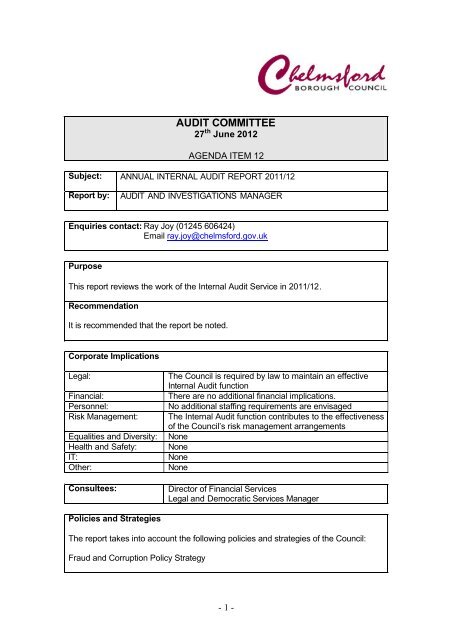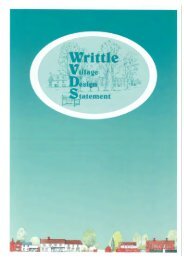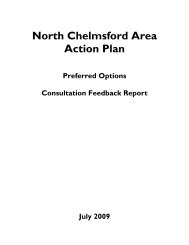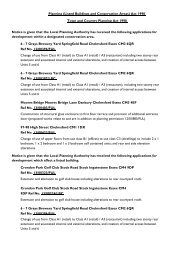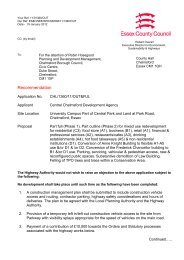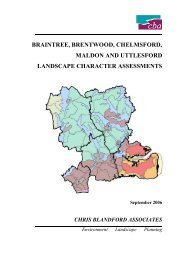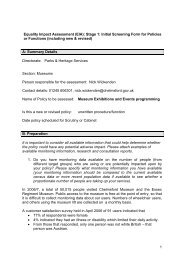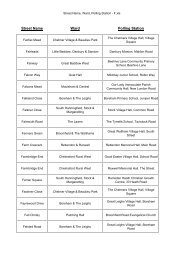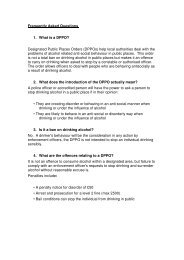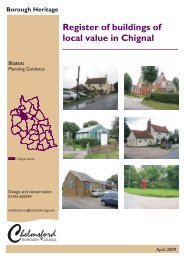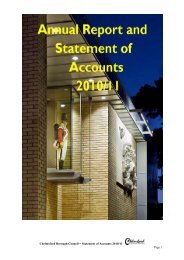annual internal audit report - Chelmsford Borough Council
annual internal audit report - Chelmsford Borough Council
annual internal audit report - Chelmsford Borough Council
Create successful ePaper yourself
Turn your PDF publications into a flip-book with our unique Google optimized e-Paper software.
Corporate PrioritiesThe <strong>report</strong> relates to the following corporate priority/prioritiesExcellent Customer Services /RenaissanceSocial InclusionEnvironmentValue for Money /- 2 -
1. Introduction1.1 In accordance with good <strong>internal</strong> <strong>audit</strong> practice in Local Government the InternalAudit Section <strong>report</strong>s to Members through an Audit Committee.1.2 The proposed <strong>audit</strong> coverage for 2011/12 was presented to this Committee on 23 rdMarch 2011.1.3 The <strong>report</strong> for the year 2011/12 is contained in Appendix 1.2. Conclusion2.1 The estimated number of productive <strong>audit</strong> days in the Audit Plan which waspresented to this Committee on 23 rd March 2011 was exceeded by:-• Additional resources being transferred from Accountancy to Internal Audit.;and• the Manager losing responsibility for managing the Policy andPerformance Team. (From June 2011)however,• It should be noted that sick leave which was in excess of that predictedwhen the Audit Plan for 2011/12 was drafted• the number of days spent on special investigations being slightly higherthan in previous average years; andIt should be noted that the Audit Plan contains a contingency for someeventualities.List of Appendices(1) Internal Audit Annual Report 2011/12Background PapersNil- 3 -
Appendix 1Internal Audit Annual Report 2011/121. Internal Audit Assurance and Reporting1.1 One key purpose of an <strong>audit</strong> is to provide the <strong>Council</strong> with assurance on theadequacy and effectiveness of the <strong>internal</strong> control framework in place to manage the<strong>Council</strong>’s key risks. The desired outcome of the <strong>audit</strong> is to make and agree relevantand robust recommendations with Directors and managers to effectively control therisks of the <strong>Council</strong>. Each <strong>audit</strong> is concluded through a written <strong>report</strong> to the relevantDirector, and where appropriate, a manager, together with the Cabinet Member forFinance and the relevant Cabinet Member.1.2 Draft <strong>audit</strong> <strong>report</strong>s and working papers are subject to a quality review, normally by theAudit and Investigations Manager, before the <strong>report</strong> is issued.1.3 The final <strong>audit</strong> <strong>report</strong> includes a summary of the key findings and conclusions togetherwith an Action Plan incorporating recommendations, responses, the names of theresponsible officers for implementing the recommendations and the agreed dates forimplementation.1.4 All <strong>audit</strong> recommendations are recorded on an <strong>audit</strong> database from which monthly<strong>report</strong>s are sent out Iisting all recommendations due for implementation by the end ofthe next month where the <strong>audit</strong>ee has not informed the Audit Team that therecommendation has not been implemented.1.5 Internal Audit undertake follow up <strong>audit</strong>s to ensure that where high and medium riskrecommendations were made in the main <strong>audit</strong> have been implemented.1.6 At the conclusion of any planned <strong>audit</strong> all high risk recommendations are <strong>report</strong>ed atthe next meeting of the Audit and Governance Committee meeting.1.7 Any outstanding high risk recommendations are <strong>report</strong>ed at Audit and GovernanceCommittee meetings.2. Performance of the Internal Audit Section – Achievement of the Annual AuditPlan2.1 The Annual Audit Plan is risk based and is kept under review in order to identify anyamendment needed to reflect changing priorities and emerging risks to the <strong>Council</strong>. Itis flexible, containing an element of contingency to accommodate unforeseen workand agreed extensions of existing work.2.2 As <strong>report</strong>ed at the March 2010 meeting some slippage occurred in the Audit Plan andthe follow up <strong>audit</strong>s which slipped will be undertaken in 2010/11 and any main <strong>audit</strong>swhich were not started were re-prioritised into the 2010/11 <strong>audit</strong> plan.2.3 During 2011/12 Internal Audit has undertaken work in the areas listed in Appendix A.- 1 -
3. Key Financial Systems3.1 All nine of the major financial systems, listed below, which PKF require this <strong>Council</strong> to<strong>audit</strong> on <strong>annual</strong> basis, were completed in accordance with the agreed PKF timetable:-• Loans and Investments• Bank and Cash Receipting• Main Accounting• Sundry Debtors• <strong>Council</strong> Tax• Business Rates• Payroll• Housing and <strong>Council</strong> Tax Benefits• Ordering and PaymentsIn addition, the IT control <strong>audit</strong> for each of the systems was completed.All the <strong>audit</strong>s were based on PKF’s Control Evaluations Summaries and testingrequirements.3.2 All the work makes a direct contribution to Internal Audit’s ability to provide an opinionof the effectiveness of the <strong>Council</strong>’s <strong>internal</strong> control environment. This is arequirement under the Accounts and Audit Regulations (2006) and contributes to theassurance in the Annual Governance Statement.4. Anti-Fraud Culture4.1 Internal Audit have continued to support, when requested, Disciplinary InvestigationOfficers in undertaking their work.4.2 Internal Audit coordinated the results of the National Fraud Initiative exercise for the<strong>Council</strong>. This is a national data matching exercise that is organised by the AuditCommission and includes data from Housing Benefits, Payroll, Creditors databases ofthe <strong>Council</strong>.4.3 PKF the <strong>Council</strong>’s External Auditor undertook a review of the <strong>Council</strong>’s fraudresilience. It concluded that <strong>Chelmsford</strong> scored 34.25 out of 50 which ‘given the rangeof issues which CBC seeks to address, the different services which it is required toprovide and the challenging financial environment, this is a respectable score.’4.5 The Audit and Investigations Manager, in conjunction with a Personal Assistant, hasalmost finalised an e-learning module on fraud and corruption which will be rolled outacross the <strong>Council</strong>.4.6 There has been greater publicity to deter housing benefit fraud and promote <strong>report</strong>ingsuspected frauds. There continues to be a significant increase in the number ofsanctions issued by the Benefits Investigation Team. This is <strong>report</strong>ed elsewhere inthis agenda.- 2 -
10. Quality Standards10.1 In December 2009 the Internal Audit Team’s ISO 9001:2000 certification lapsed.Owing to the reduction in the Internal Audit staffing levels it was decided by theteam not continue to retain the ISO 9001:2000 certification but maintain theirworking papers according to that quality standard. This has resulted in days whichhad previously been spent on undertaking quality <strong>audit</strong>s in order to adhere to ISOquality standards now being used to undertake <strong>audit</strong>s.11. Audit and Governance Committee11.1 The Terms of Reference for the Committee are based on Chartered Institute ofPublic Finance and Accountancy’s (CIPFA) recommended core functions of anAudit Committee together with some added by Members of this <strong>Council</strong>.11.2 The Audit and Investigations Manager is the Lead Officer for the Committee and issupported by the Director of Financial Services and the Legal and DemocraticServices Manager.11.3 In accordance with Best Practice, a review of Audit and Governance Committee’sTerms of Reference for 2011/12 was undertaken and is <strong>report</strong>ed elsewhere in thisagenda.11.4 In accordance with the Extraordinary meeting of the <strong>Council</strong> on 2 nd May 2012, it wasagreed that that the Governance Committee will ‘approve and monitor the Code ofCorporate Governance and the <strong>Council</strong>’s Annual Governance Statement with theAudit Committee’.11.5 The Audit and Investigations Manager <strong>report</strong>s on high risk recommendations whenthey are identified and listed if they remain outstanding beyond the agreedimplementation date.12. Benchmarking and Best Practice12.1 It is disappointing to <strong>report</strong> that owing to the reduction in the number of District<strong>Council</strong>s subscribing to the Institute of Public Finance’s Audit Benchmarking Clubfalling below twenty it was decided not to participate in this benchmarking exerciseas the results would make comparisons very limited. This <strong>Council</strong> has supported thisexercise since the first year and was represented on the Steering Group.12.2 <strong>Chelmsford</strong> has taken on the responsibility of chairing the Essex Audit Groupmeetings and the meetings are held at the Civic Centre.12.3 It is also disappointing to <strong>report</strong> that PWC Masterclasses which are normally held inor around Cambridge were not held in 2011/12. These meetings have proved usefulin the past as <strong>audit</strong> representatives from outside Essex attended and provided auseful networking basis.- 4 -
13. Performance Indicators13.1 At the September 2008 meeting of this Committee, the Audit and InvestigationsManager <strong>report</strong>ed on the four indicators used by his team to measure performance.The four consisted of:-• Satisfying the External Auditor;• Retaining ISO 9001:2000;• Scoring in excess of 90% satisfaction on the questionnaire returned by<strong>audit</strong>ees on the completion of each planned <strong>audit</strong>; and• Keeping within the Team’s financial budget.13.2 Members at that meeting requested that productive time as a percentage of totaltime be added to the list.13.3 Performance Indicator Comments for 2011/12a) Satisfying the External Auditor The Audit and Investigations Manager isunaware of any problems which have arisenduring the course of the external <strong>audit</strong>.b) Retaining ISO 9001:2000 Owing to staff reductions the ISO wasdiscontinued from December 2009.c) Scoring in excess of 90%satisfaction on thequestionnaire returned by<strong>audit</strong>ees on the completion ofeach planned <strong>audit</strong>d) Keeping within the Team’sfinancial budgete) Productive time as apercentage of total time14. StaffingOnly four questionnaires were received. Anyinterpretation of the results is thereforeextremely limited however the lowest markwas ‘happy’ out of four levels of ‘very happy’,‘happy’, ‘unhappy’ and ‘very unhappy’.Owing to one employee having significantsickness absence, additional resources werebrought in and this has been paid for by theoverall Audit and Investigations staffingbudget.Productive time fell slightly in 2011/12because the team made use of an apprenticeand this resulted in the filing system beingrevised and also an accountant wasseconded to the team from Accountancy andshe spent time on learning the <strong>audit</strong>procedures. There was also a significantdecrease in the number of sick days. Thisresulted in an increase in the number of <strong>audit</strong>days.14.1 During the year ending 31 st March 2012 the Audit staffing establishment consistedof the Manager, two Principal Auditors, a Part-Time Auditor equating to about .5 of afull time equivalent (fte). The seconded Accountant from Accountancy to Auditincreased resources by.41fte. A temporary Auditor equating to .03 fte was bought intogether with a temporary IT Auditor was bought in equating to .2 fte. The Managerhas spent .19fte of his time on managing the Benefit Investigations Team.- 5 -
14.2 One of the Benefits Investigators who is an Accredited Financial Investigator isassisting in a case which has been referred to the Police.15. Recommendations15.1 Members of the Audit and Governance Committee receive <strong>report</strong>s listing high riskrecommendations from each completed <strong>audit</strong> together with a list of where high riskrecommendations have not been implemented in accordance with the agreedtimetable.15.2 At the March 2012 meeting of this Committee the Audit and Investigations Manager<strong>report</strong>ed that there had been a reduction in the number of outstanding high andmedium risk recommendations.16. Reporting16.1 The Audit and Investigations Manager has <strong>report</strong>ed to the Director of FinancialServices since the post of Deputy Chief Executive was deleted in June 2011.16.2 The Audit and Investigation Manager considers that this change has not led to anyloss of independence.16.3 The Director of Financial Services has chaired an Audit Workshop which hasreviewed the service.16.4 The Audit and Investigations Manager has quarterly meetings with the CabinetMember for Finance and the Audit Chairman at which matters of concern arediscussed.16.5 In exceptional circumstances the Audit and Investigations Manager would discussany serious confidential matters with the Chair and Vice-chairman of the Committee.17. Audit Opinion17.1 In line with the Accounts and Audit Regulations 2006, Internal Audit are required toprovide an overall assurance assessment of the <strong>internal</strong> control arrangements of the<strong>Council</strong> at the end of each financial year. This provides both management andMembers with an indication of the robustness of the <strong>internal</strong> control framework.When taken in conjunction with Internal <strong>audit</strong>’s work on corporate governance andrisk management this provides evidence on which the Annual GovernanceStatement can be signed.17.2 In the opinion of the Audit and Investigations Manager, the <strong>Council</strong> hasdemonstrated effective controls in most systems. The basis of this overalljudgement is contained in Appendix A of this <strong>report</strong>.17.3 The Audit and Investigations Manager has the opportunity to raise any <strong>audit</strong>concerns at Audit and Governance meetings.- 6 -
17.4 However, overall the Audit and Investigations Manager is satisfied that, for the sizeof the authority, there is an effective system of <strong>internal</strong> control but it should be notedthat with the contraction of the workforce, new controls will continue to have to beconsidered.18. Conclusion18.1 The role of Internal Audit has been described as that of the ‘finger on the pulse ofthe organisation’ and in this role can assist management by being a <strong>report</strong>ing andself regulating mechanism.18.2 Through the <strong>audit</strong>s carried out, Internal Audit ensures that the control systems whichoperate within the authority are effective and are properly followed, and that thepotential for fraud is minimised. This provides a good indicator to the Director ofFinancial Services, (the Section 151 Officer, responsible ‘for the properadministration of the financial affairs of the <strong>Council</strong>’) that things are working well.18.3 In taking a view of the <strong>Council</strong>, the external <strong>audit</strong>or is influenced by the evaluation ofthe quality of Internal Audit and hence to the extent of their <strong>audit</strong> work. The quality ofthe work of Internal Audit has reduced the number of days the external <strong>audit</strong>orneeds to work at the <strong>Council</strong> and therefore this has reduced the level of fees paid tothe external <strong>audit</strong>or.- 7 -
Appendix A2011/12 Areas covered for which an Audit Opinion has been givenCash and BankMain Accounting<strong>Council</strong> TaxBusiness RatesLoans and InvestmentsPayrollHousing BenefitsIncome and DebtorsOrdering and PaymentsMain Financial Systems IT ControlsTheatresSponsorshipTown Centre MarketFixed Penalty NoticesIT Internet, emails and virusesIT Business ContinuityCar AllowancesDovedalesRiverside Ice and Leisure CentreName of AuditSouth Woodham Leisure CentreBuildings:- Hylands House, Oaklands Museum, <strong>Chelmsford</strong> Sports andAthletics Centre, and Market Road Public ConveniencesOpinionSubstantialFullFullFullFullSubstantialFullSubstantialSubstantialSubstantialSubstantialSubstantialSubstantialSubstantialSubstantialSubstantialSubstantialSubstantialSubstantialSubstantialSubstantialAudit OpinionLevel ofassuranceFullSubstantialLimitedNoDescriptionThere is a sound system of <strong>internal</strong> control designed to achieve theobjectives of the system/process and manage the risks to achievingthose objectives. Recommendations will normally only be Advice andBest Practice.Whilst there is basically a sound system of control, there are someareas of weakness, which may put the system/process objectives atrisk. There are Medium recommendations indicating weaknesses butthese do not undermine the system’s overall integrity. Any high riskrecommendation relating to part of the system would need to bemitigated by significant strengths elsewhere.There are significant weaknesses in key areas in the system ofcontrol which puts the system/process objectives at risk. There arehigh risk recommendations indicating significant failings.Internal controls are generally weak leaving the system/processopen to significant error or abuse. There are a number of high riskrecommendations indicating major failings.- 1 -
Other areas covered by Internal Audit for which no opinion was given as only a followup <strong>audit</strong> was undertakenProcurement and Credit CardsCemetery and CrematoryPlay AreasCorporate Issues Procurement CardGifts and Hospitality<strong>Chelmsford</strong> Sports and Athletics CentreEnvironmental Services - LicensingCivic Centre Cash CollectionStaff RecruitmentContaminated LandFood SafetyManagement of Town Centre Partnership- 2 -


